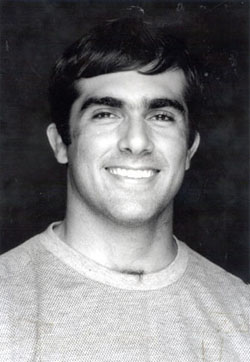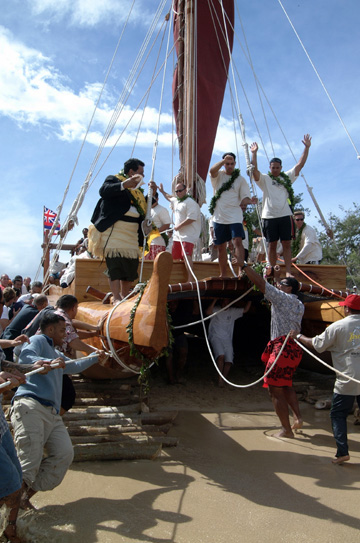
Documentary filmmaker
Daniel Skaf
 INTRODUCTION
INTRODUCTION
Skaf: The Hawaiian culture has always fascinated me. The intelligence required to memorize 150 stars, their various positions in different times of the year and use them as a map is amazing. When I saw the huge logs which were just brought to the building site, I could not resist but make a documentary about the building process. As the canoe would take at least a year to be completed, I knew I would be able to learn more about their culture.
Q. You're not Polynesian, but nearly everybody in the documentary is Polynesian. Were you concerned about your ability to portray Polynesian cultures accurately?
Skaf: Yes, I was. That is the reason why I worked very closely with the executive producer [William Kauaiwi'ulaokalani Wallace III], who is the director for the Hawaiian Studies Department at Brigham Young University-Hawaii, and also the main person behind the building of the canoe. I knew I had to tell the story from a Hawaiian point of view. I spent a lot of time researching the history of voyaging canoes and also a lot of time talking to the people involved. For a while, I had to deny my own culture and beliefs, and immerse myself in that new experience. Although I am not a Pacific Islander, I tried to think and act as a Hawaiian. It was a great learning experience which increased my respect for this great people.
Q. In making "The Birthing of Iosepa", what equipment did you use during filming and post-production?
Skaf: I used both mini and regular format digital cameras. The Sony cameras were DSR-300, DXC 327 with DVCAM deck and PD-100. For post, I used Final Cut Pro and Panasonic DVCPRO tapes. For graphics, Compix.
Q. How much did "The Birthing of Iosepa" cost to make?
Skaf: That is a hard question. I didn't receive a budget to make the documentary. It was one of my assignments at the Olelo Community Television station I worked for. BYU-H paid for the tapes and the TV station paid for my time during the filming and post. I spent 400 hours editing and used 60 tapes during a year.
Q. When you had finished "The Birthing of Iosepa," what was the biggest difference in the film from how you originally planned it?
Skaf: During pre-production, I wanted to do a documentary in the style known as verité, which is like the ones made in the sixties. A documentary without much editing, which allows the actions and situations during the construction process tell the story by itself. That is the way that I videotaped, filming almost every action, every conversation. However, during the writing of the script, I decided to change that. I wanted to blend both time periods, during and after the carving. Having the people involved looking back and reflecting upon the carving of Iosepa and also talking about their feelings during the carving period.
Q. Some of the interviewees in the documentary speak Hawaiian, which I'm sure some mainlanders think is an extinct or nearly-dead language. Is Hawaiian the native language of these people, or did they learn it as a second language in the Hawaiian language immersion school?
Skaf: There are people who grew up speaking Hawaiian in their homes and others who learned at school. Since Captain Cook arrived on the Hawaiian Islands in the end of the eighteen century, Hawaiians started to be deprived of their own identity. In the nineteen seventies, they built the voyaging canoe Hokulea, and traveled to Tahiti without modern navigational instruments. That was one of the events that marked the renaissance of the Hawaiian culture. Today, the Hawaiian language is becoming more and more widely spoken.
Q. Have you had a chance to receive feedback from audiences about "The Birthing of Iosepa"? What are some of the things that regular viewers liked?
Skaf: So far, I received many positive feedbacks from both Pacific Islanders and people who don't know anything about Hawaiian culture. Some of the Hawaiian audience came to me and expressed their gratitude through tears. That was the best feedback I could ever receive. The people who don't know much about Hawaiian culture told me they now have more respect for these great people. The goal was accomplished.
Q. The documentary often features a remarkable -- and apparently very authentic -- blending of traditional Polynesian religion and Latter-day Saint practice, sometimes most noticable in the wording of prayers, blessings and chants. In making or showing the documentary, did you receive any resistance or criticism about the religious content?
Skaf: No, I didn't receive any criticism about the religious content. It was great to see how both Polynesian and LDS beliefs blended. As the canoe project was created by the Hawaiian department of BYU-H, the religious beliefs were already mixed. One day a friend told me that the deeper you go into a culture, more universal characteristics you will find.
Q. How can people have a chance to see "The Birthing of Iosepa"?
Skaf: The documentary will be shown at the Hawaii International Film festival during the first week of November, 2002. It will also air on DirecTV, through the BYUTV channel. I don't have the airdates yet but it will probably be shown in December or January. People can email me to get the airdates (skaf100@chapman.edu).
Q. You previously made the documentary "Keepers of Culture." What was that about?
Skaf: It is about the 2000 Culture Night of BYU-H, in which 30 student clubs from various parts of the world present their traditional culture through dance and music. We chose two groups, the Maori (New Zealand) and the African clubs and did a documentary about their preparation for the event. One of the interests was in the people who were not Maori or African, but joined the clubs to learn more about them. We also focused on the ways these two groups of people maintain their culture while studying in an American university.
Q. Imagine you have the opportunity to make a big budget film. It can be a documentary, a narrative feature, anything. (Up to $40 million for production.) What's the topic? Who's in it?
Skaf: I would choose one of the many great stories of the Book of Mormon. This is one of my goals. I would like to do it in Hawaii or Brazil, since both places have tropical forests. I would choose actors who are in the beginning of their careers and make them read the Book of Mormon at least one time. I am amazed by the amount of LDS filmmakers who are sprouting up everywhere. I know in the next 30 years we will see amazing epic LDS movies such as Ben Hur. I want to be a part of it.
Q. What is your next project?
Skaf: For now, I am devoting 100% to my graduate program in Film and Television Production at Chapman University, which is a 3 year program. I am still deciding if I will choose a documentary or a narrative film for my thesis project. But definitely I'll try to make it educational and uplifting.

| Documentary: | The Birthing of Iosepa |
| Directed, written and edited: | Daniel M. Skaf (skaf100@chapman.edu) 714-283-0449 |
| Directed, written and edited: | Daniel M. Skaf |
| Executive Producer: | William Kauaiwi'ulaokalani Wallace III |
| Script Supervisor: | William Kauaiwi'ulaokalani Wallace III and Kamoa'e Walk |
| Script Editor: | Jacquelyn H. Skaf |
| Narrators: | Jim and Ipolani Thompson |
| Music: | Vaihi |
| Graphics: | Ali J. Burgess |
| Camera: | Yohei Araki, David Bowen, Siana J. Burgess, Kristyn Davidson, Mike Foley, Nathaniel Hansen, Leah Kihara, Bruno Lemos, Maureen Montana, Nathan Petty, Daniel Skaf, Tammy Toma, Gael Weberg. |
| Interviewees: | Elder M. Russell Ballard, Clay Bertelmann, Wright Bowman Sr., Namealoha Curtis, Uncle "Big Boy" Enos, Kehau Enos, Kawika Eskaran, Bula Logan, Keali'i Maielua, Gary Nagy, Chad Paishon, Mau Paiailug, Tuione Pulotu, Jude Sells, Sipa Shimizu, Eric B. Shumway, Ken Steinmetz, Nainoa Thompson,Vaitoti Tupa, Luther Waiwaiole, Kamoa'e Walk, Ka'ano'i Walk, William Kauaiwi'ulaokalani Wallace III, Mikilani Yuen |
| Fijian translation: | Inoke Suguturaga |
| Hawaiian translation: | Kamoa'e Walk, Ka'umealani Walk, William Kauaiwi'ulaokalani Wallace III. |

Documentary filmmaker Daniel Skaf |
Script Supervisors
William Kauaiwi'ulaokalani Wallace III
Kamoa'e Walk
Script Editor
Jacquelyn H. Skaf
Graphics
Ali J. Burgess
Canoe Drawing
Kawika Eskaran
Camera
Yohei Araki
David Bowen
Siana J. Burgess
Kristyn Davidson
Mike Foley
Nathaniel Hansen
Leah Kihara
Bruno Lemos
Maureen Montana
Nathan Petty
Daniel Skaf
Tammy Toma
Gael Weberg
Paintings
Herb Kawainui Kane
The Petroglyph Maker
Hokule'a II
The Discovery of Hawaii
Preparing Food for the Voyage
In the Canoe Halau
Crossing to Moloka'i
The Tree Cutters
Ka'anapali 200 Years Ago
Consultation at the Heiau
The Launching
Bishop Museum
Outrigger Canone
Native Village Scene
Native Hawaiian
Polynesian Triangle Map
Ancient Adze
Interviews
Elder M. Russell Ballard
Clay Bertelmann
Wright Bowman Sr.
Namealoha Curtis
Uncle "Big Boy" Enos
Kehau Enos
Kawika Eskaran
Bula Logan
Keali'i Maielua
Gary Nagy
Chad Paishon
Mau Piailug
Tuione Pulotu
Jude Sells
Sipa Shimizu
Eric B. Shumway
Keo Steinmetz
Nainoa Thompson
Vaitoti Tupa
Luther Waiwaiole
Kamoa'e Walk
Ka'ano'i Walk
William Kauaiwi'ulaokalani Wallace III
Mikilani Yuen
Translations
Fijian
Inoke Suguturaga
Hawaiian
Kamoa'e Walk
Ka'umealiani Walk
William Kauaiwi'ulaokalani Wallace III
Footage from
"The Making of the Camakau"
The Institute for Polynesian Studies, BYU-H
Jerry K. Loveland, A. LaMoyne Garside,
David Paxman, Sandra Banack,
Lawrence Lau, Vernice Wineera.
Footage from Meleniume
Ma'ake
Tuione Pulotu
Footage from Fiji
Pasifika Communications, Suva, Fiji
Peter Lee
Pictures/Paintings of
Iosepa colony and
Pres. Joseph F. Smith
Brigham Young University-Hawaii
Special Thanks to
W. K. Kellogg Foundation
Olelo Community Television
Kahuku Satellite
Tammy Toma
Siana J. Burgess
Main Office
Thomas Galli
Kit Kawamata
Leah Kihara
Melvin Kouchiyama
Bishop Museum
Tom Cummings
Vaihi
Aaron Ka'onohi
Brigham Young University
Hawaii campus
Greg Gubler
Randy Sasaki
Rob Wakefield
Polynesian Cultural Center
Hawaii Reserves, Inc
The Jonathan Napela Center for
Hawaiian Language and Cultural
Studies of BYU-H
And to all the volunteer hands from
various places of the world who
made the dream of Iosepa
come true.
Facilities provided by
Olelo Community Television
Kahuku Satellite
(808)293-9357
The executive producer is
responsible for the content of this
program. To contact the producer,
skafdaniel@yahoo.com